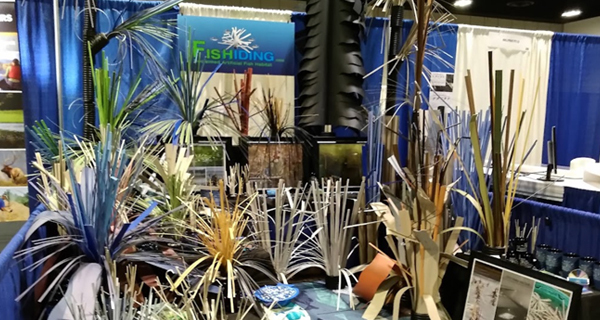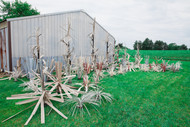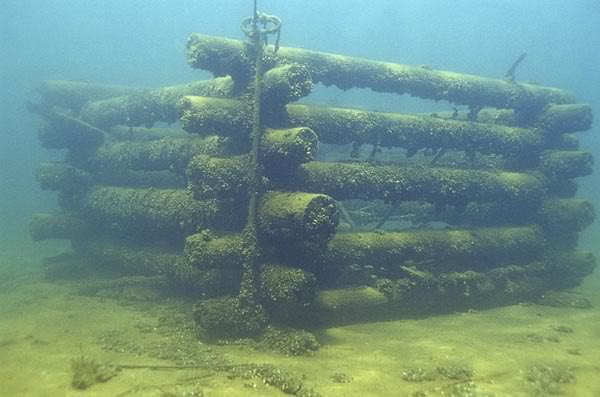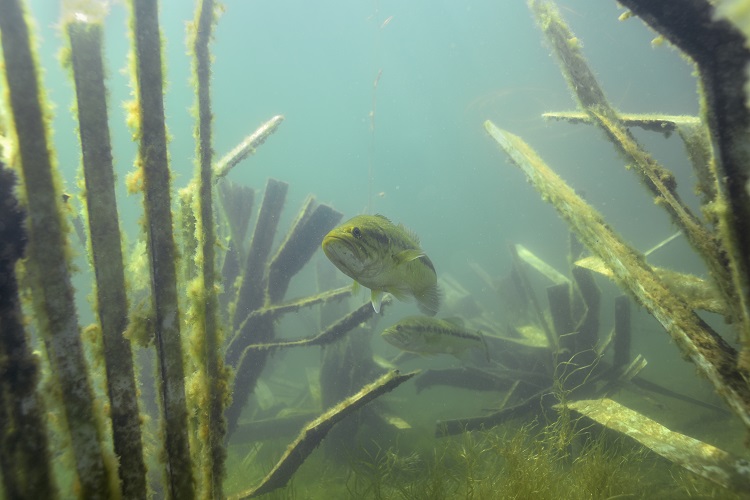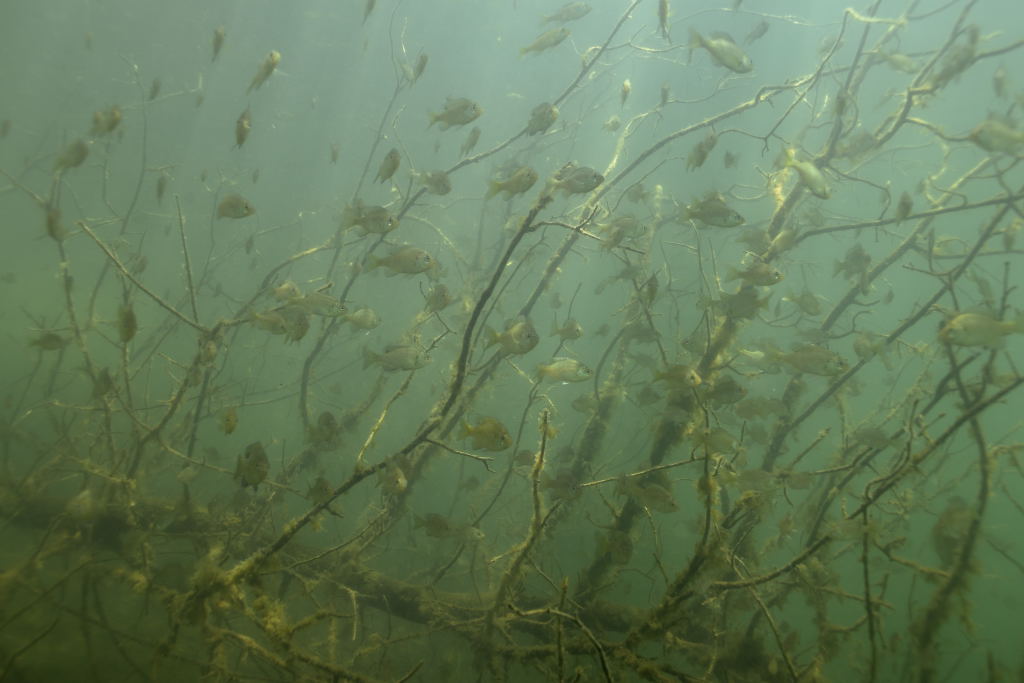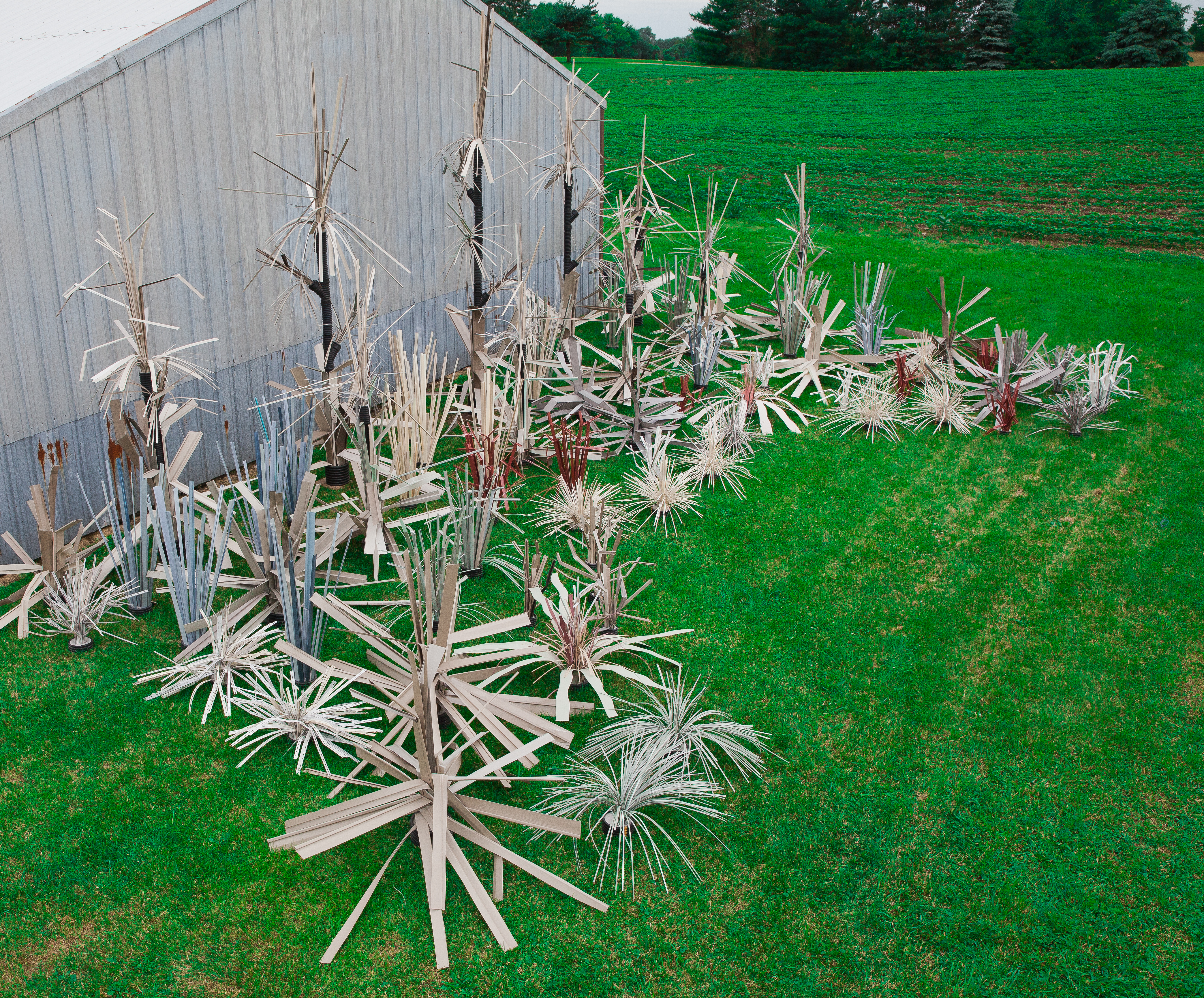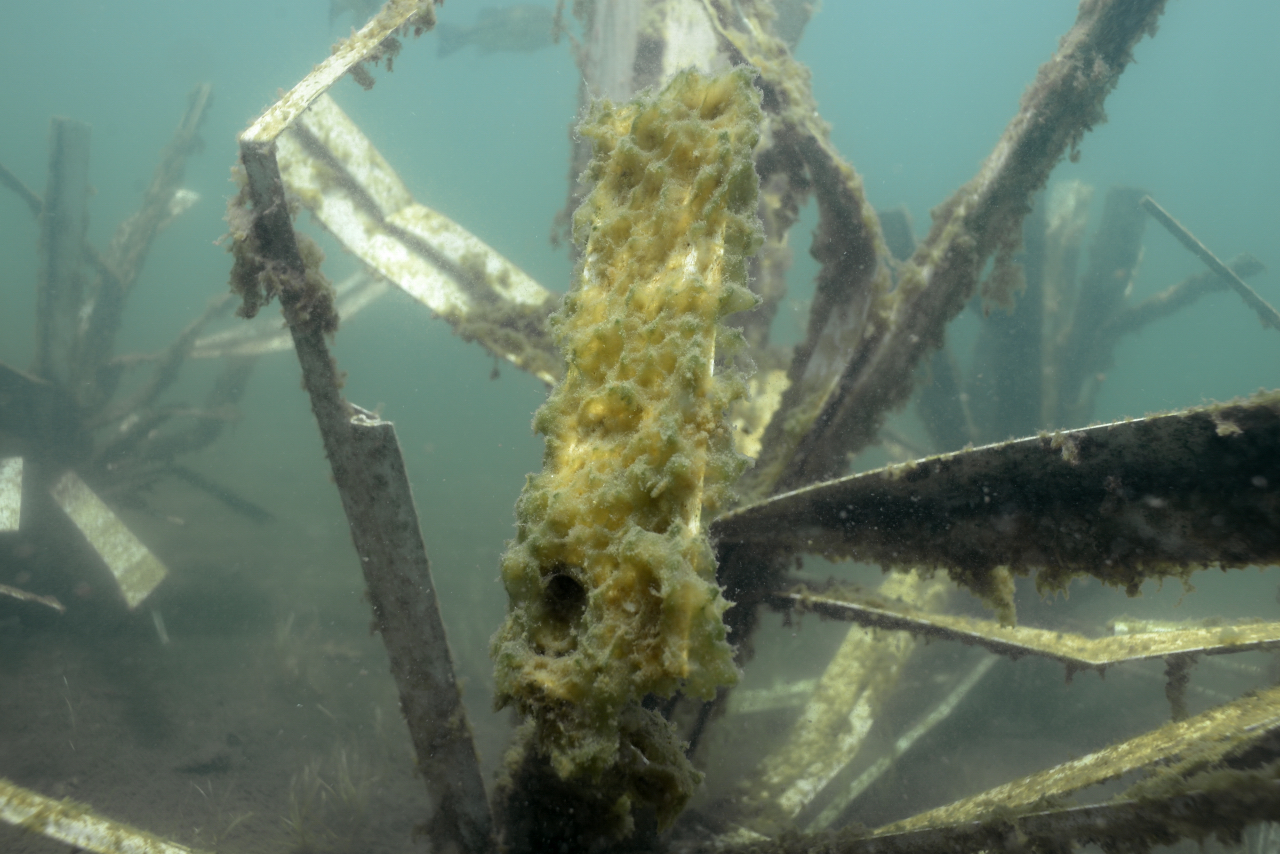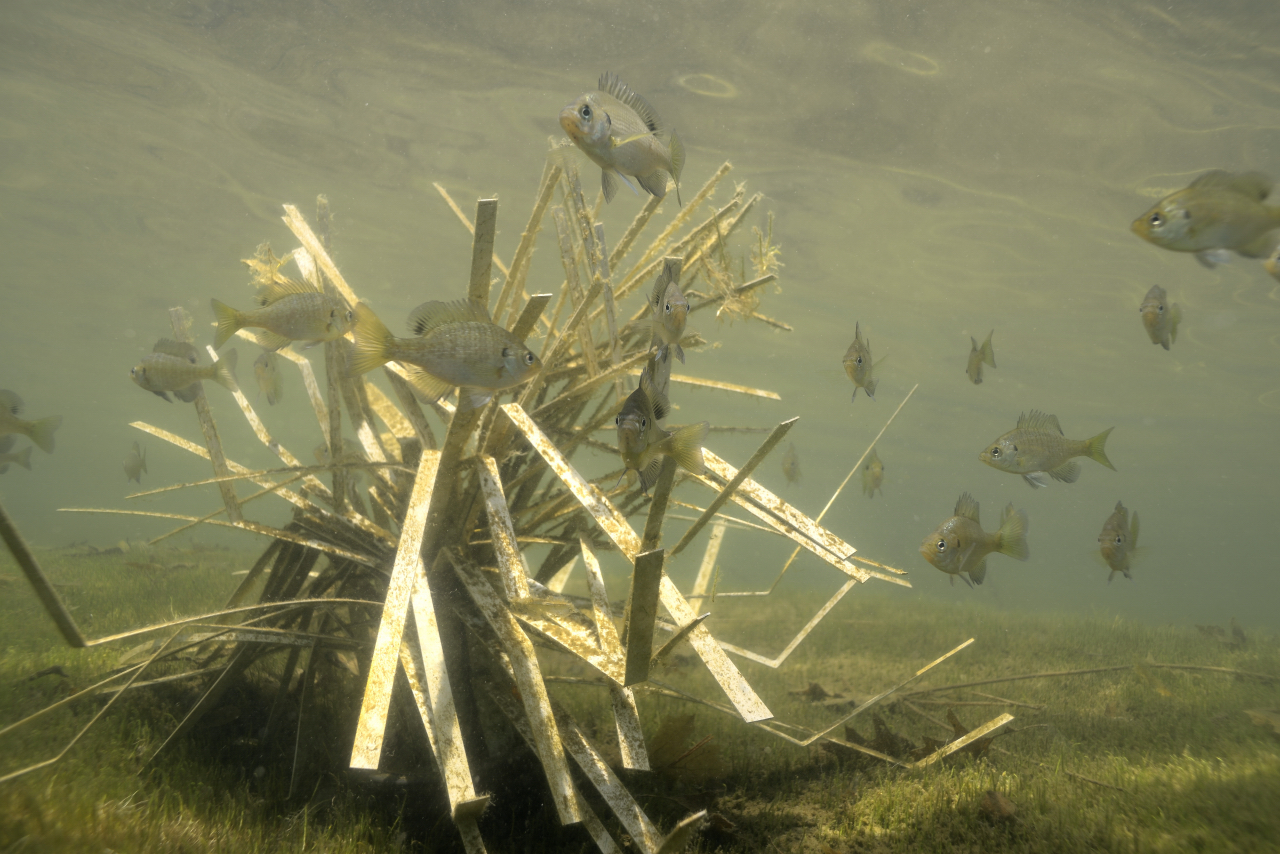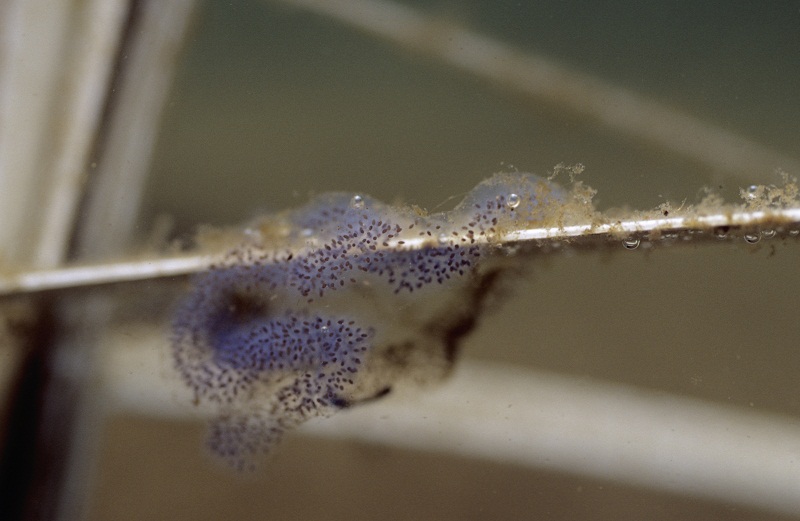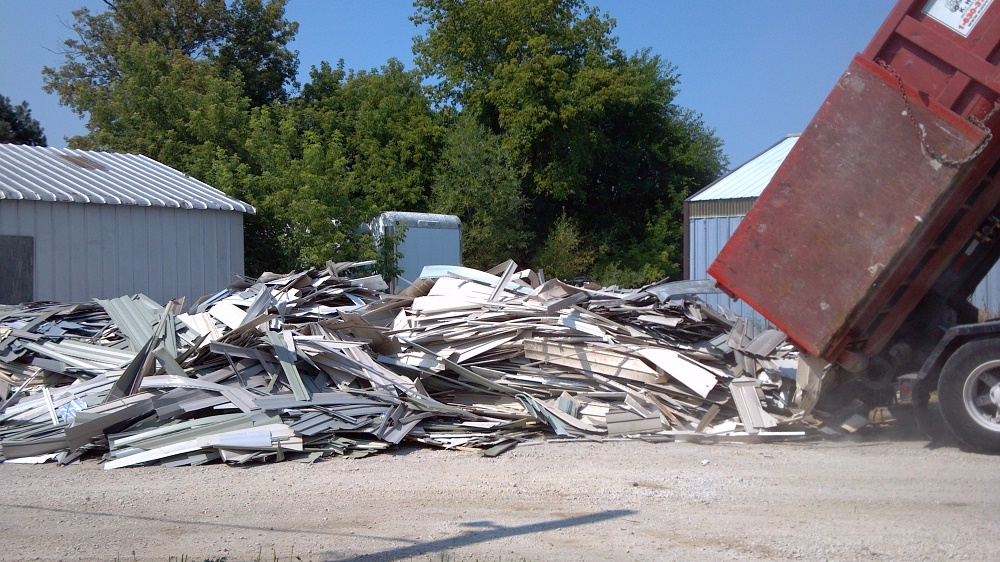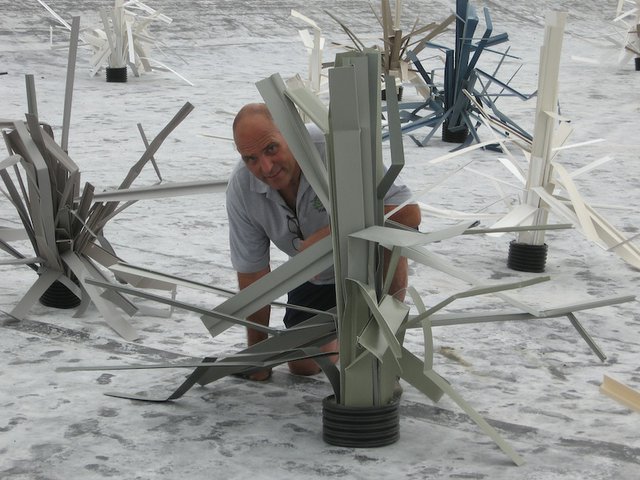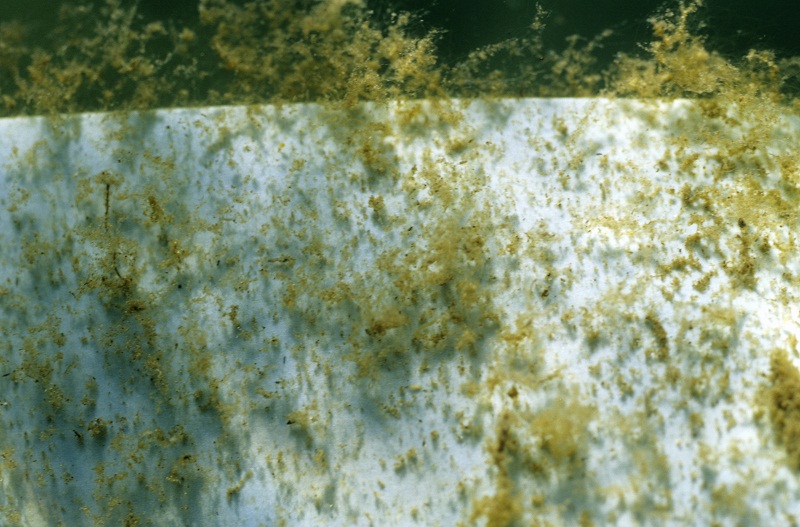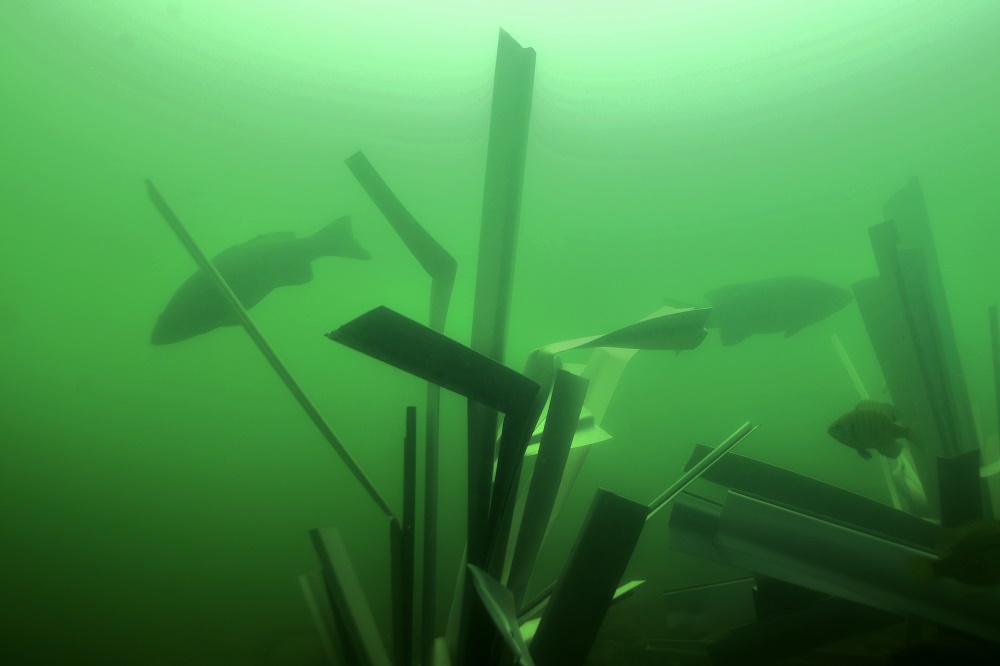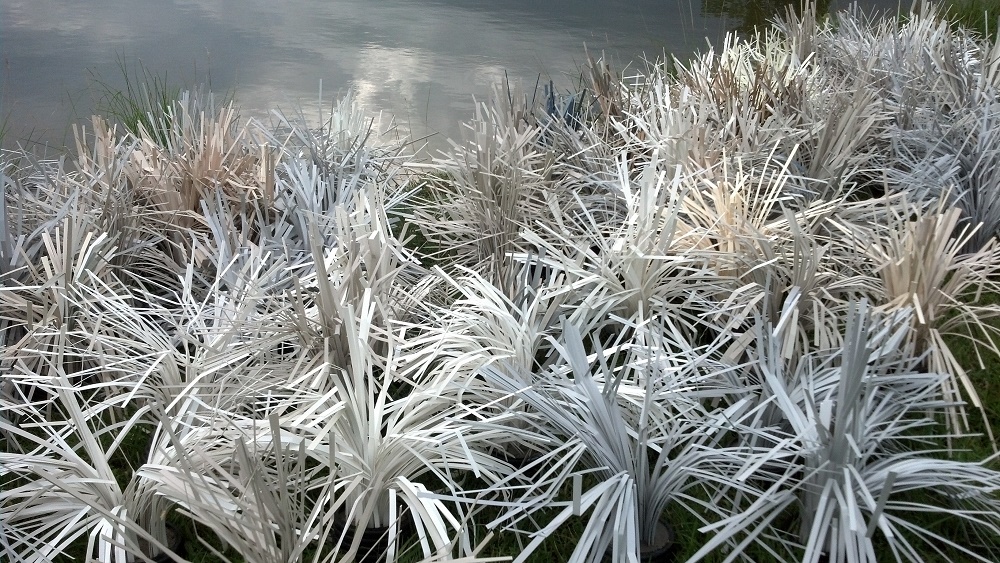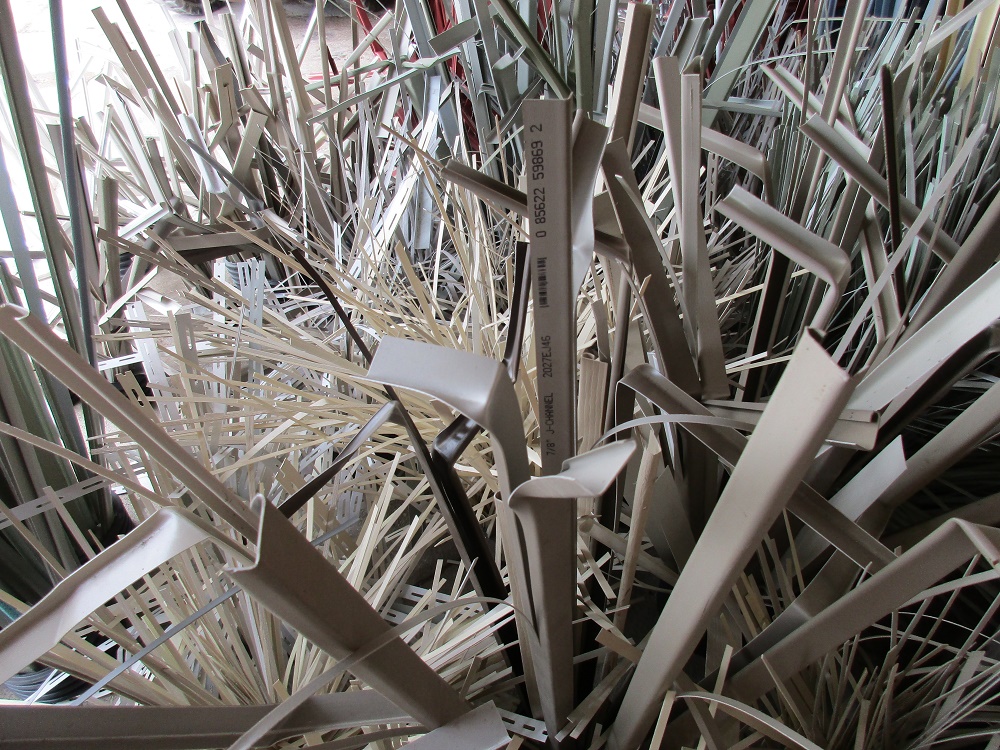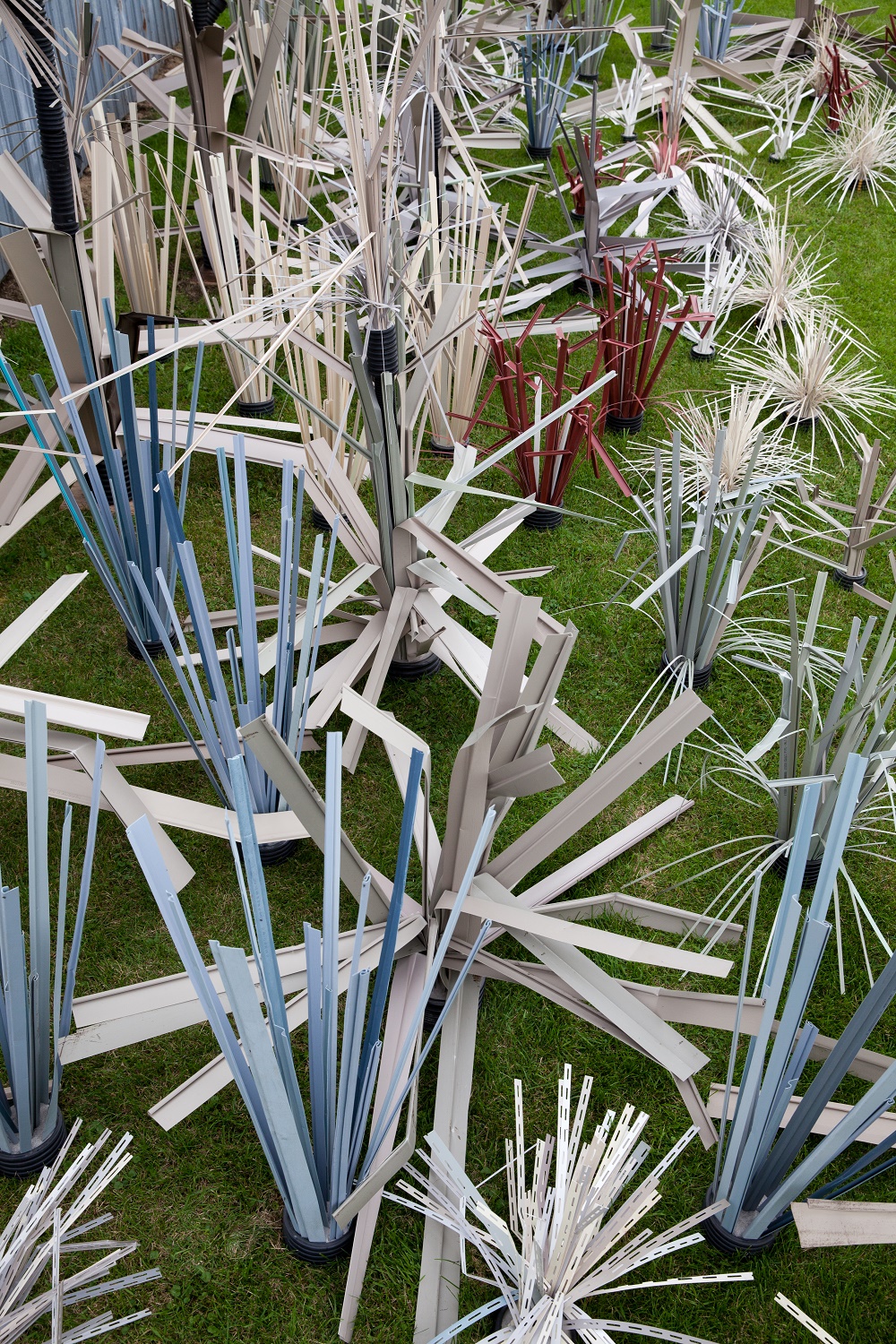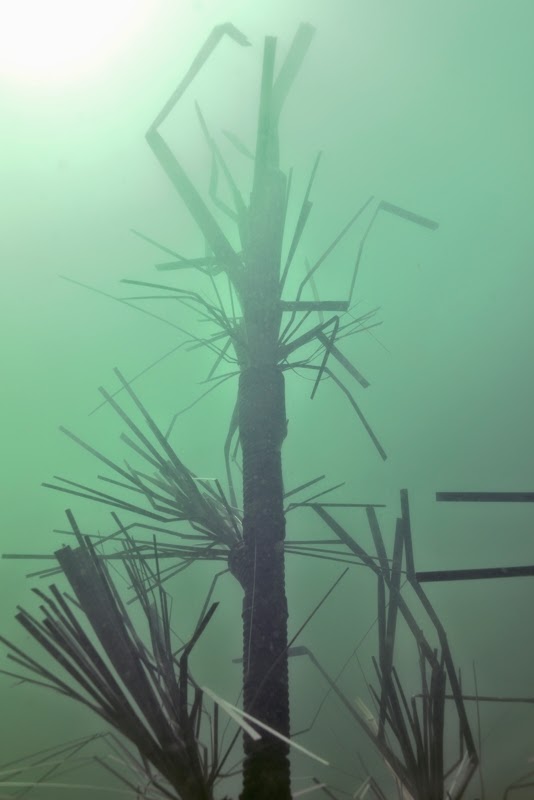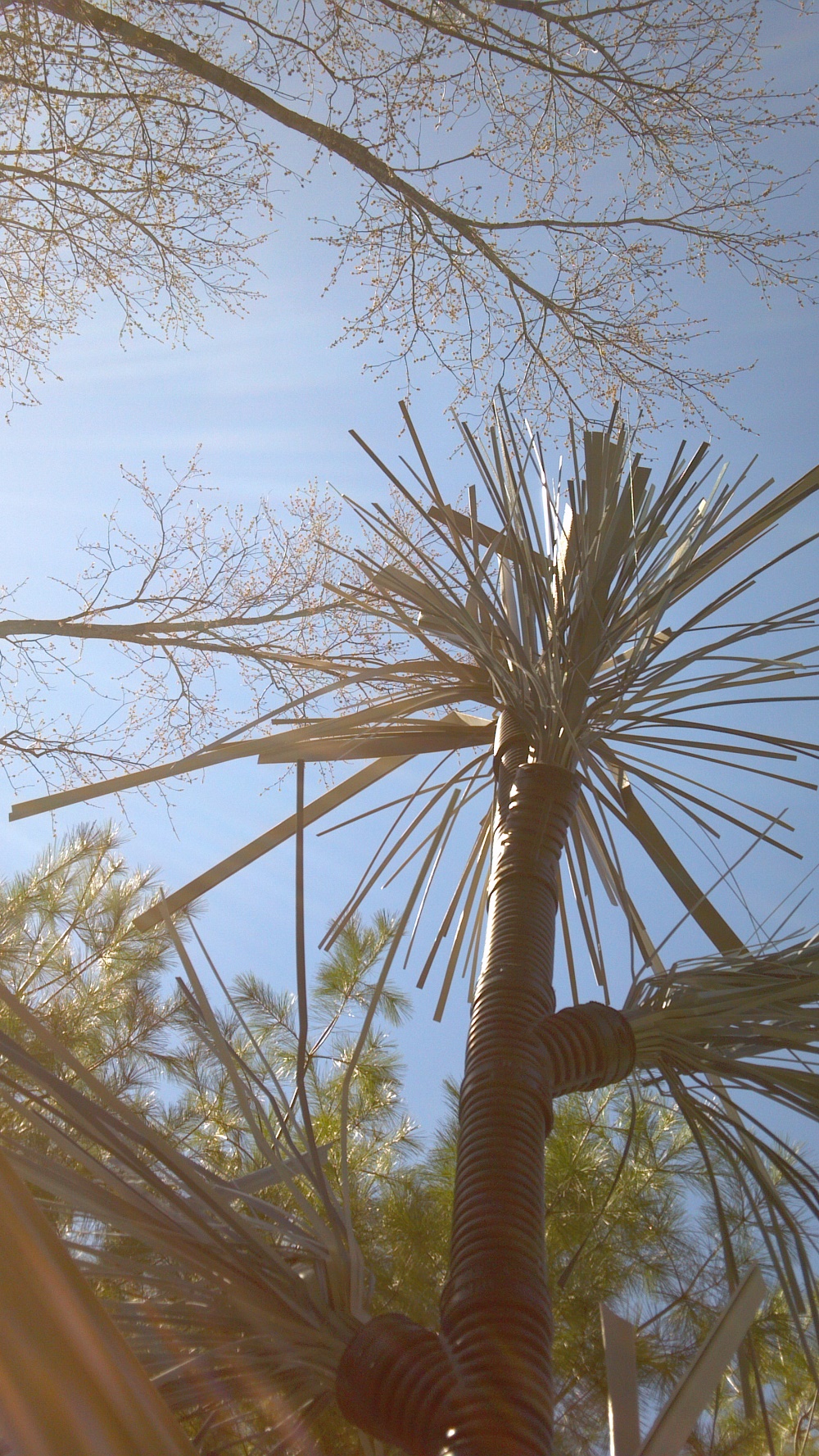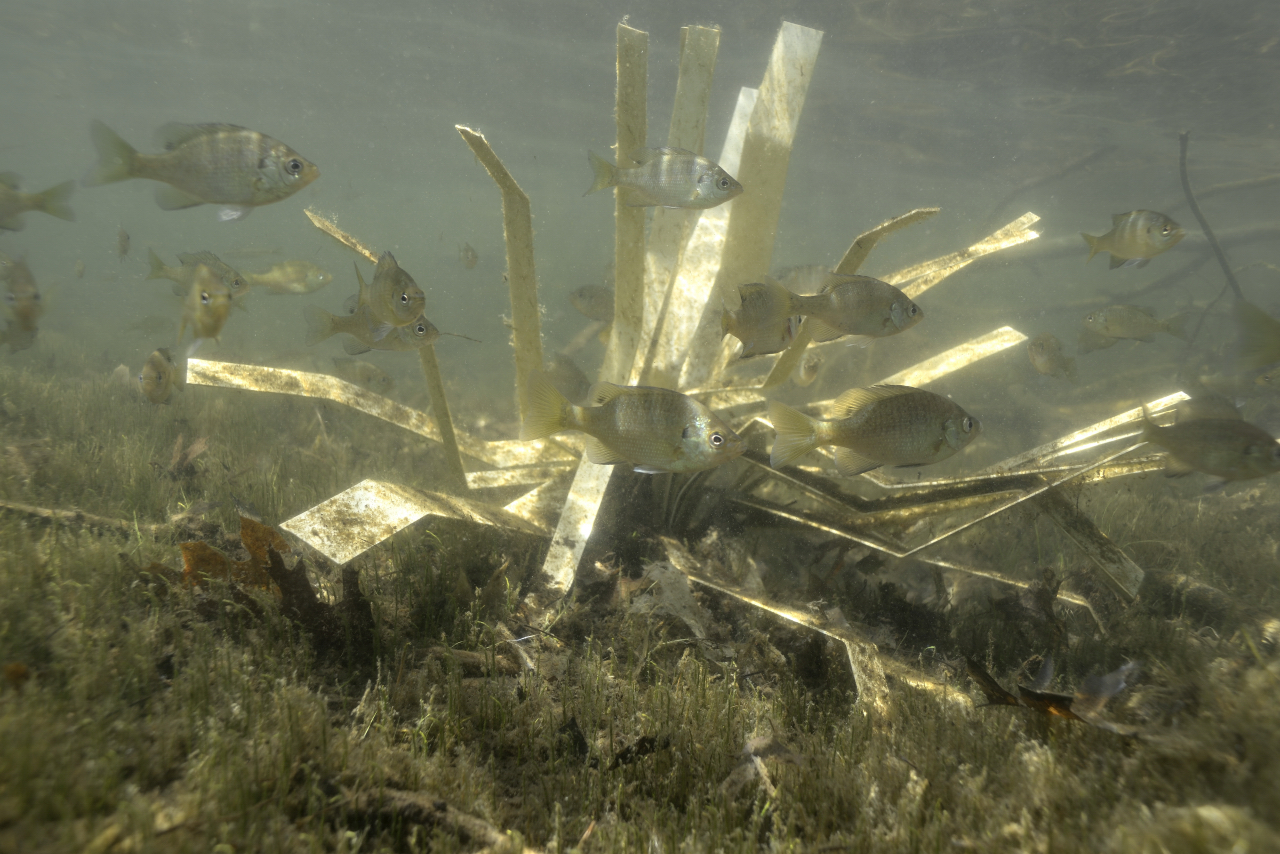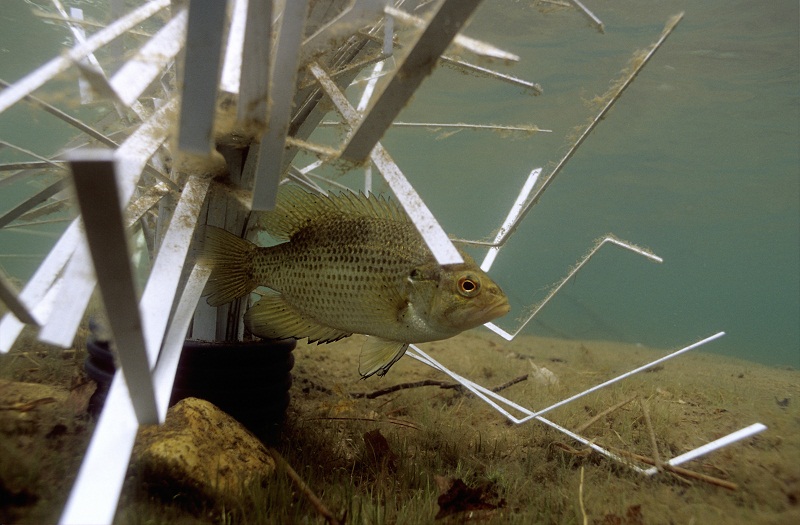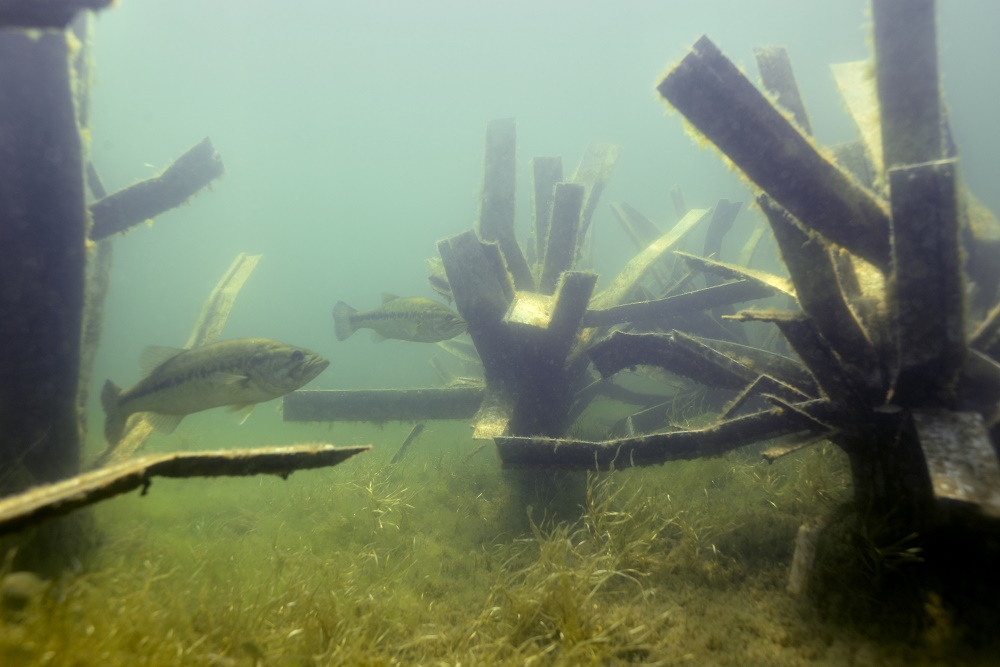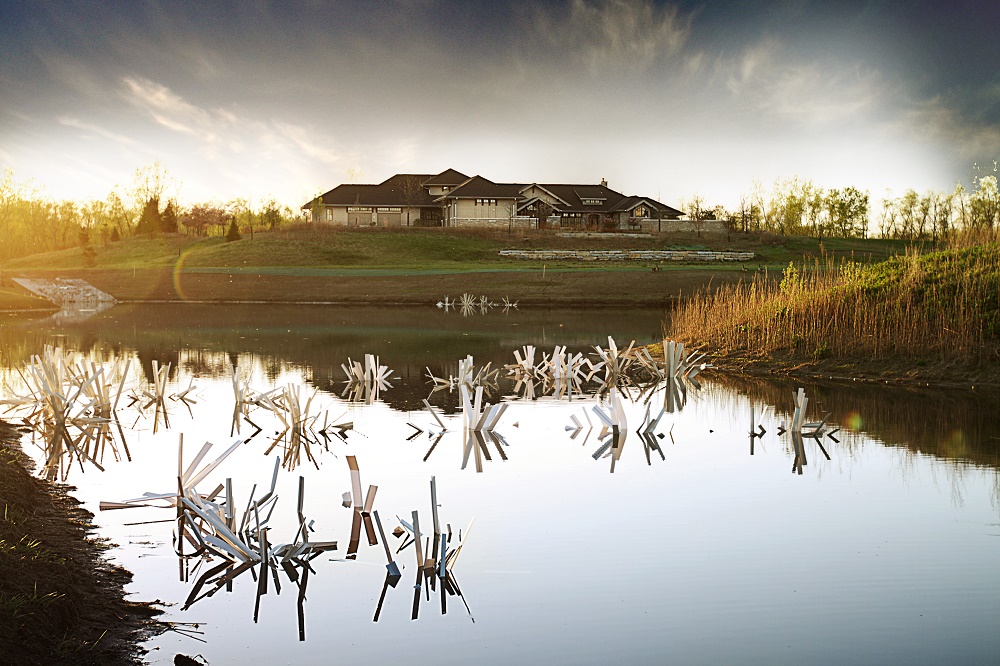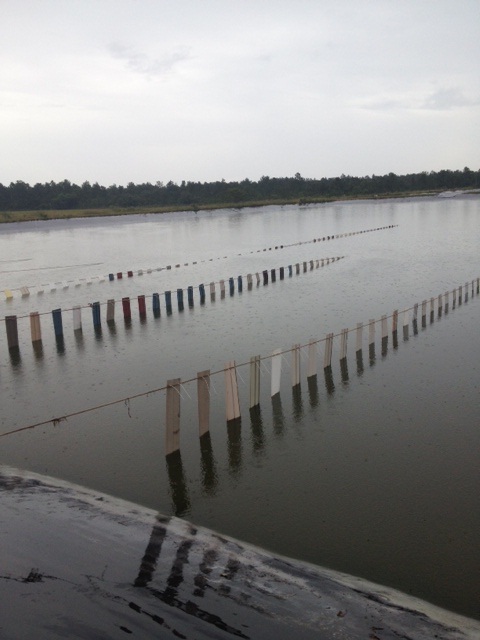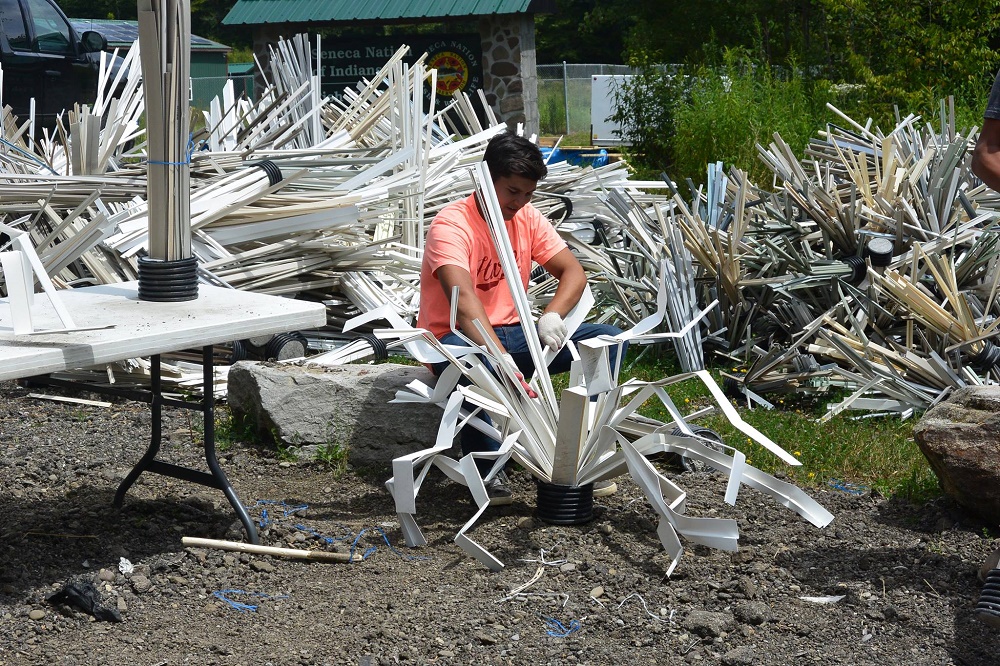Artificial fish habitat or fish attractors, which do the fish need and why?
Posted by David Ewald on 12th Jan 2016
First off, let's not continue to confuse fish habitat with fish attractors. There are many substantial differences between the two and what each product is intended for. Both products attract fish, but only true habitat can grow more fish.
Under the Fisheries Act, fish habitat is defined as: “Spawning grounds and nursery, rearing, food supply and migration areas on which fish depend directly or indirectly in order to carry out their life process. (Fisheries Act Section 34(1))”.
Artificial fish habitat as defined above, is simply habitat that is man made with materials not found in nature. Although made from mainly plastics, the intended goal is absolutely the same. Reproduction and protection of more fish.
The planting of native aquatic plants, installing brush, rock, deadfalls and timber would be considered supplemental natural habitat. These types of materials succeed in replacing natural materials that have decayed or have been lost to siltation, erosion and development, but were once present.
Artificial fish attractors attract larger fish and little more, accomplishing the intended task as designed. Open in design and able to see through, generally tubes and sticks that are easy to get fishing lures around, they attract larger fish to a designated area for a short time in transition between cover, made for fisherman to enjoy. One job well done when placed and designed in such a manner that the desired species of fish feel comfortable using it.
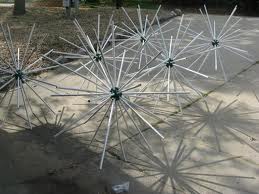


Artificial fish habitat also attracts fish for fisherman however, it also provides a place for fish to raise young, lay eggs, feed and provide protection from danger, amongst many other postive benefits. Fry and forage species are the key to sustainability, protect them and there will be plenty of larger fish to catch. Stock the lake's shelves with food and some will get very big. Legitimate artificial fish habitat attracts fisherman....to the areas the fish already live.
As fish habitat restoration projects continue to gain momentum world wide, countless groups are planning and installing a gambit of different approaches to both attract fish and/or grow more fish. Natural materials such as aquatic plantings, wood, rock, boulders, rubble and gravel, continue to improve fish habitat as nature once balanced.
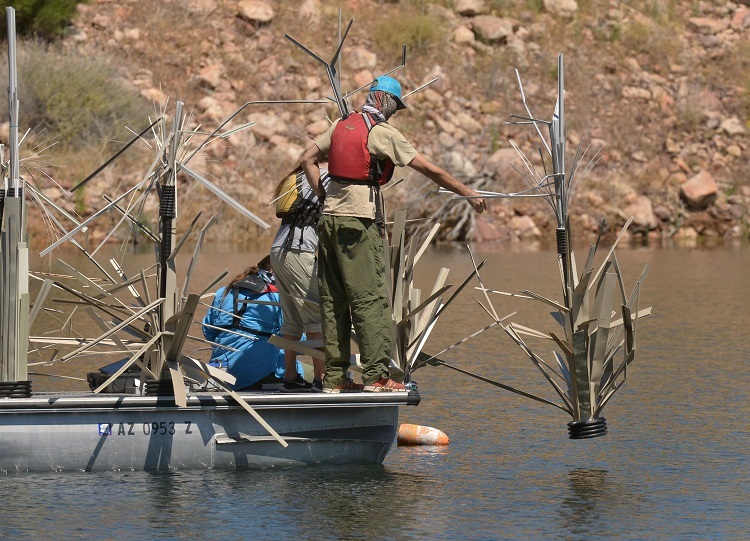
Christmas trees are well know as great fish habitat, why? They have the dense, abstract and dark tight spaces that have no uniformity of any kind. Every single tree is unique as it lays on the lake floor, creating infinite hiding spaces, closely resembling aquatic plants and deadfalls. Nature rarely produces exact twins...........identical is not natural or preferred by fish, which our study dives continue to confirm. Fish seem to select their spot, unique to others around them, possibly recognizing their uniquely shaped "door" into their house and safe zone.
With all the recent momentum in the rush to improve habitat in our waters using artificial products, the industry appears to be lacking actual published data of what the fish prefer and why. At Fishiding.com, we have been studying fish preferences of artificial materials/habitat for over 9 years, starting underwater with the fish. We all agree that in a devoid under water landscape, fish will use what they have available to a large degree but not all ideas and materials being placed currently will bring the same expected positive results. Most everyone involved in fisheries management is now getting on board with accepting artificial habitat, with some experts are even saying "works better than natural materials". Let's not start simply dropping objects in the lake that we think "should work", expecting fantastic results. Closely copying nature provides best results.



Some cube designs of woven corrugated/slotted pipe, create the perfect habitat setting for catfish of all varieties to take refuge within. Unlike most fish species, the catfish thrives in a dark hollow they can back into. The downside to this may be the intended species of fish hoped to utilize the new cover actually stay clear of the possessive catfish and his bite. Spacing of the pipe and complexity of the center will determine fish use often.
Our diving was underwater testing, we studied the findings of what fish prefer most when artificial habitat is needed and installed in various depths and water types. Testing in dark waters and clear, spring through fall and winter ice, obvious tendencies occurred overall. More variation holds more fish.
Unfortunately, many of the objects currently being used as fish attractors/habitat, fall far short of what fish preferred in our tests and photographs. Eric Engbretson talks about why fish cribs work and why they fail in an earlier article, written by a veteran underwater freshwater fish photographer. Although complexity is natural, repetitious design of man made products continues to "look good" to man, not so much to the fish.
Fish would shop for function over fashion if they could, never feeling man's view of what should work, or looks good was important. Finding a few fish on an artificial object being occasionally checked, does not mean beneficial habitat has been created, simply an attractor has been found. Habitat promotes fish growth. Attractors promote fish catch.
Spending our budget dollars for the fish wisely, will pay dividends for future generations. Finding out a few years down the road that your investment didn't pay back what you expected, brings your waters back to square one.
One thing has become commonly clear, fish habitat has been lost and our fish and waters are in bad shape. Good intentions to improve a fishery can easily run off target, if a full understanding of the goals and how to achieve them are not planned in advance. Water type, fish species, existing size class fish, forage, available habitat/cover as well, are only a few criteria that will play into making the best and most cost effective decisions to meet those goals.
Open spaced items will attract predators looking for forage or rest. Tight , dense spaces are where these small fish and invertebrates are hiding. Here, they find refuge and food, amongst the cracks and crevices good habitat creates, grazing on periphyton. They will use the best spaces available. Products that have a mixture of dense and open habitat spaces prevail.
Sections 1-16:
1.Goals
2.Common Ground
3.Materials/Plastic types and properties/ loose or integrated components
4.Rigidity/Flexibility of the artificial materials and structures
5.Surface area /shape/surface of substrate
6.solid portion/shade
7.Density
8.Uniformity/Variety/Texture and Size of habitat
9.Vertical height/Vertical stability on steep and un-even underwater terrain/fishing interference
10.Color
11.Weight/Anchoring
12.Assembly time/needed supplies/tools
13.Cost of habitat/ $ per square foot of surface area/ equipment-additional supplies
14.Location of installation
15.Versatility of intended use
16.Fishiding Artificial Fish Habitat Facts
1.Goals:
Are you looking to hold a few fish in a certain area for fisherman, or is the goal to improve the fishery by protecting and growing more fish, which in turn improves the fishing? Fish attractors or fish habitat? Only true habitat can offer both refuge to grow more fish and provide the location to to outsmart a big fish with rod and reel. Attractors bring fisherman to fish and are made to help congregate and catch the bigger fish in the lake but not protect.

2.Common Ground/Agreed Perceptions:
Let's start with what attractor and habitat companies, fisherman and Biologists all seem to agree on about good fishing and fish habitat of any type. It is assumed that natural habitat materials include things found openly in nature and installed directly into the water. Wood, plants, rock of all types and sizes, brush, stumps etc. all come directly from nature, none of which are exactly the same as the next. Artificial habitat materials are made from man, being plastics, metals, fiberglass or objects held together, framed or enhanced by the same. Fish seem to most love some of each, variety is the spice of life, even for fish. Years of underwater observations have continued to confirm this.
* Growing fuzz/algae/periphyton is important and good. The more surface area an object has underwater, the more fuzz it will grow. The fuzz is food for young fish and bugs. (This is really important)
* Shade is good. All species need protection from direct sunlight at times. Fish prefer some kind of limb/substrate over head. Something between them and the lake floor whenever available during loafing times.
* Tight/Complex spaces are good. Punching through thick growing mats for example, allows fisherman to access the areas fish feel safe. Underwater pictures confirm although fish will stage outside and around tight cover at times, home and safety is within tight, confined spaces.
* Snag/proof/resistant is good for fisherman, not so much the fish. Fish need to have cover that completely protects them from intrusion when needed, including fisherman. Large groups of habitat should allow fisherman to work outside the cover and edges. Other fish can stay protected in the dense center sections, eluding predators as they to leave the protected areas.
* The larger the area of habitat/structure, diversity increases and the better the fishing can get. Big size, equals big numbers of inhabitants. When talking about improving a fishery with artificial habitat, it's generally because it lacks enough natural habitat to sustain good fishing.
* Variety of materials like wood and weeds on a rocky point near each other, are best for fishing, . Often fish are found at transitions between different types of materials and bottom makeup, including depth. Areas with a variety of habitat densities, textures, material types, depths, and heights are sought out by fish. Variety of habitat hold a variety of food for all.
* Flat surfaces like plant leaves and particularly the underside, provide the suitable and needed substrate for fish and countless aquatic life to adhere their eggs. Food brings predators. Topside, these flat surfaces gather sunlight, growing abundant periphyton and casting cool shade. As plants die off, their flat leaves/ surfaces are lost throughout the winter months, while artificial materials can stay working 12 months of the year.
* Large scale restoration projects require multiple days and many people to install a large group of habitat. Faster assembly and installation with less or no loose parts or tools, makes this work more cost effective and efficient. Cost, effort and time matters, even when volunteer help is available to assist.
The above points can be used to help determine which types of artificial habitat may fulfill your goals and help your fishery the most, after all isn't it all about the fish?
Changing company names, copying verbage, ideas and marketing strategy, does not make artificial fish habitat from a fish attractor design.
3.Materials/Plastic types and properties/ loose or integrated components:
Plastics lead the way in artificial habitat materials for their inherent long lasting qualities. Recycled plastics may have an array of different chemical makeups from mixing multiple materials together through re-manufacturing, thus generally not meeting more stringent product requirements.
Polyethylene is a rigidly formed plastic with shaped memory, usually molded directly into the part. Tubing, gas line/hose are examples of this plastic, keeping their curled shape with a smooth finish. This material is generally to rigid to be bent and is designed to keep it's shape indefinitely. Parts are molded and formed in this material to create a sturdy part and is most always lighter than the water it displaces and floats without added weight to keep it down when used for fish attractors.
When attaching different types of plastics to each other, care must be taken to allow for expansion and contraction. All of these materials have unique characteristics which allow them to expand with heat and shrink with cold at different rates. What this means for attractors and habitat is some parts may feel tight when installing in the sun above water, but when submerged and cool off, individual pieces can become loose and fall off. Thickness, type, shape and size of pieces will all react differently. Stories of tubes washing up on shore, limbs slipping out or to one side are the result this expansion and contraction. Additional fasteners should be considered.


Cables, ropes, bolts, hooks and chains can have long life spans underwater, although most will rot away over time. Aside from getting hooked on these items, if after time, any fastener fails once deployed, then the loose parts can detach. Stainless and galvanized steel can/will rust away over time underwater. Care must be taken to use a heavy enough product to fasten to ensure the habitat unit will not become loose, moving freely along lake floor.
PVC plastic is a remarkable material which can be bent, twisted, curved and manipulated. Being softer and more flexible than most other readily available plastic, this material can be formed and re-formed multiple times, then conforming to the intended shape. The most abundantly used plastic, millions of tons annually are buried into landfills. With less than 10% of the pre and post consumer PVC being recycled/reclaimed, this inert and stable plastic is available in countless forms. Because such an overabundance of readily usable, safe plastics are available worldwide, we see no need to produce new plastics for fish habitat. Not unlike we humans, the fish prefer variety in their lives.
Fishiding.com has been creating the perfect abstract framework of fish habitat exclusively from PVC products that are destined for landfills. Most materials like vinyl siding, wall coverings and sheet goods, Architectual mouldings and roll stock, come unused from overstock, discontinued and old inventory stock. Reclaiming this pre and post consumer material and using it in its original form without recycling or manufacturing. "Helping fish, the environment both above and below the waterline, was the goal which started it all."
Glues, solvents, shims, separate bases, fasteners and cables all take time to manufacture, prepare and install. These individual pieces create joints and potential weak spots throughout the habitat unit. Take special care to ensure these components are secure.
Only Fishiding habitat products come in a patented self weighted base with no loose parts or assembly required. Models that self un-fold and stand vertical directly out of the box. No possibilities of fastener failures or need for tools or additional supplies, boats or manpower.
4.Rigidity/Flexibility of the artificial materials and structures:
In nature, materials of all variations of rigidity exist both under water and at the water's edge. Rock, concrete, posts/pipe, big wood, etc., have no flex and stay rigid in place where they rest. Smaller limbs, tree tops and aquatic plants, all have varying flexibility. This flexibility also changes over time as natural materials begin to decay and weaken, thus flexing even more until failure and falling to the lake floor.
The observed best case scenario for fish preference is a combination of rigid and flexing members, some moving and some fixed. Unlimited variation in size, flexibility, shape and density are all natural, therefore most beneficial to fish of all age classes and therefore, sought out.
Like a plant, artificial habitat should be seated on the lake floor, allowing it to sway and move with the currents or fisherman's interference from above. A rigid structure will simply fall over when to much force is applied. Other options are to suspend units from ropes and floats,but snagging into these lines is assumed.
Pre-manufactured and mass produced parts stay identical one to the next. Underwater studies show fish utilize and prefer varying textures and variety of habitat types, including flexibility, stiffness and density whenever present.
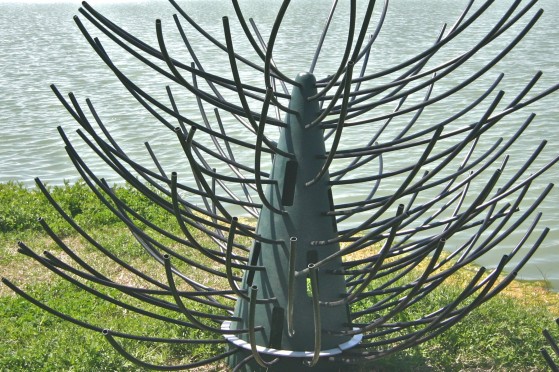

Not all plastics and artificial materials have the same bending and flexing characteristics. If the parts are the same and repeated, then your flexibility of design and function stops there, with one fixed variable. Each unit will generally have the same number of rigid branches or sticks, possibly some continuous corrugated pipe, over and over again.
Fishiding habitat products are made exclusively with substantially flat pieces of PVC vinyl of varying widths and thicknesses, coming from dozens of different sources and industries. This unique and fully patented concept, allows unlimited variation not only in material shape, type, thickness, makeup and size, but also by simply bending individual pieces by hand, creating yet a different set of rigidity memory into the pieces. Unlimited flexibility from hundreds of unique types of PVC, allow lifelike movement and flow under water. Materials standing stiff in any direction, down to pieces so fine, larvae flow within it's protection.
Fish need variation in their surroundings for a most beneficial environment with as many different options to hide and hunt as possible.
Largest fish in the system will often take the most prime locations of cover for residence. Like a big bully, a big fish seeks out the best ambush points, shadows and hiding spot, pushing out smaller fish.
5.Surface area /limb shape/surface of substrate:
The amount of surface area an object has underwater directly relates to many important factors of fisheries science. Aquatic plants grow in countless shapes and forms, each having unique leaves, shoots and textures that all contribute to the surface area of that plant. Within this maze of fibers and crevices, periphyton grows by removing nutrients from the water. The more fertile the body of water, the faster and more growth will normally occur.
Periphyton/algae will grow on literally anything underwater. Periphyton grows on plant leaves and stems underwater in which fish and zooplankton graze upon. It is believed that roughened or textured surfaces allow this growth to better, firmly attach. Rocks, plants, wood, rubble, specific plastics, metal , etc., all have somewhat rough finishes and grow periphyton readily in fertile waters where light can penetrate to the limbs. Flat PVC is an excellent substrate in all colors, allowing the maximum surface to point upwards towards the sunlight.
The key here is the waters. Depending on how fertile the waters are with nutrient loading, the speed and amount of growth achieved will vary. All waters vary from each other, season and year. With this in mind, variation in size, shape and texture allows maximum possibilities for different degrees of light penetration, temps. and periphyton growth.
Surface area shape can also create shade in infinite patterns, shapes and densities. This combined with the available food source, makes for a perfect natural appearing fish habitat. Limbs near the surface gathering the most light will build up the heaviest growth. Like solar panels, these objects soak up warmth and light, providing living and edible cover. Variety of limbs, pieces and sizes makes for the most suitable artificial habitat.
Flat surfaces throughout all of Fishiding habitat products gather maximum light in the water. Length with varying thickness, profile and dimensions, allow life-like rigidity and flexibility combined, underwater. With this understanding from the start, Fishiding fish habitat products continue working to increase surface area in all models, while combining even more variety of pieces, types and profiles.
More and wider limbs, add up to additional surface area and Fishiding fish attractor products offer the most in the business.
Round surfaces whether smooth or textured, have only a small portion facing directly upwards to gather direct light, thus not accumulating near the amount of growth all around the diameter.
Cupped or V-shaped limbs gather sediment over time, thus eliminating the surface area to grow periphyton.
If pieces are not able to flex and flow with water movement, sediment robs the surface area and the most beneficial part of the unit is lost.
White PVC plumbing pipe actually has an algae prohibitor mixed right in the plastic because of it's intended use. Different types of plastics do not all accept this sought after growth the same.(see sect. 3 )
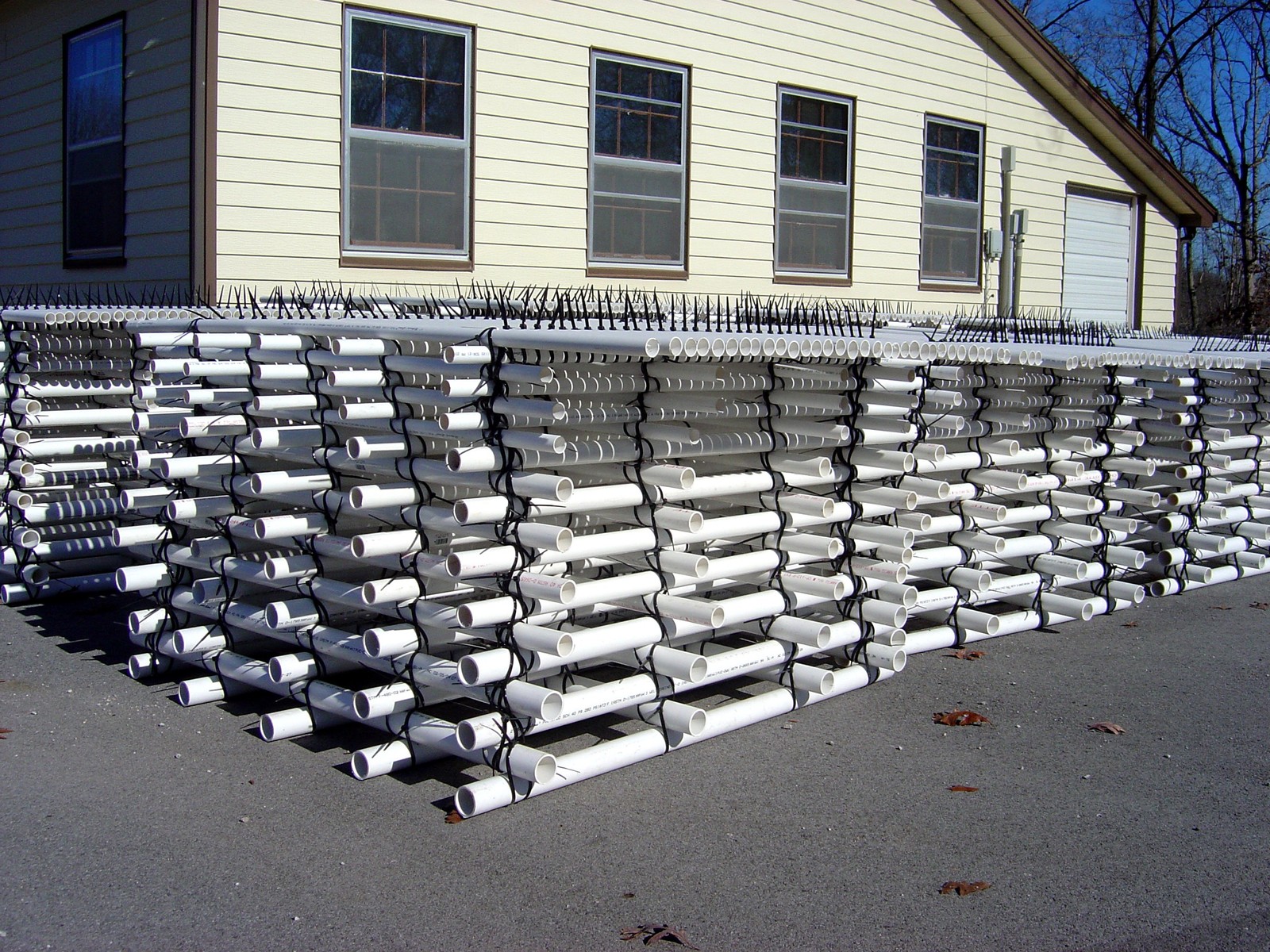
Ask a crappie fisherman why he continues to cast into the snag filled limbs and tips of dead fall trees with risk of breaking off. He or she will most likely tell you it's because the fish prefer those tight, hard to reach spaces...and why the fish are in there in the first place! This is what fish prefer and what makes density and complexity, key components of fish accepted artificial fish habitat.
6.solid portion/shade:
This section talks about how fish utilize solid objects underwater, including the shade cast from the object shape as well. If you consider survival for fish as a game of hide and seek, it all makes sense. Studies show products used to improve fish habitat and increase fish numbers, require a substantial center section, which offers density and shade, along with something to truly hide behind.
A solid, wide and abstract shaped center line, allows fish to hide and hunt behind, around and over this dense object, hiding completely from view of predators from at least one side. Habitat that provides spaces and tightness, gives optimum escape routes and passage ways to utilize. The more limbs, angles and complexity available, the easier both hiding and hunting becomes.
Shade is another important criteria for all fish species to have available to them. Shade not only allows shadows for fish to hide within, but lowers water temps slightly as well. Fish can sunburn, needing the ability to cool off and rest at times like all living beings. Ambush points from the darkness that shade provides, is essential for balanced fisheries success. Water clarity plays a big part of fish location, light penetration and everyday fish behavior.
Biologists state a minimum of 20% of a lakes surface area needs to consist of suitable fish habitat for a well balanced fishery/waterway, as much as 50% or more in some cases.
A one acre lake needs 8712 square feet of surface area of fish habitat. (That's feet, not inches)
7.Density:
If your goals are to grow more game fish fish by protecting and enhancing the existing forage base in your lake, then you want habitat that has density, variation and lots of crevices. Just like a rabbit in a briar, the little guys need tiny spots only they can fit into and feel safe. Periphyton will consume these areas, adding to the protection and food available to the young fry
.
The idea is to create as thick and complex a jungle as possible. The final result will resemble a thick mass of long branches extending from the dense pack inside the habitat unit/s. The branches should reach from every depth of every unit in every direction and at every possible angle. If your finished habitat unit looks even vaguely tidy, it needs more work. (E. Engbretson)
Picture a 20 gallon aquarium and just two larger fish that eat small minnows for food. In order for the feed minnows to have any chance of living longer than a micro second once dropped in, what type of objects/habitat would need to be in place? If the new habitat was open enough for the bigger fish to access, it's over for the minnows. Multiple ways to get in and out would help the minnows survive a little longer, maybe some spots they could rest in for protection. How much dense cover would you need to add, allowing the minnows to actually flourish, breed and increase numbers? Now scale up to a lake where the minnows are young fish fry, trying to survive through adulthood, enough living for reproduction and fishing enjoyment. Density.
Unfortunately, less than 5% of almost all stocked fish fry/fingerlings are assumed to survive through adulthood. This in part, can be caused by release into insufficient dense, shallow habitat, which would better allow safe protection from easy predation. Along with not yet having any experience with open water and instinctual habitat needs, fish coming from a hatchery grow pond, have much working against them as they are set "free" the first number of days after release. With the proper habitat, nature can increase these odds dramatically in favor of fish reproducing naturally in the lake, thus needing less or no supplemental stocking.
Always release new fish into shallow, dense cover and away from presumed predator locations for maximum survival of fry/fingerlings. Tempering your fingerlings in cover for just a few hours before release, has been proven to increase survival.
8.Uniformity/Variety/Texture and Size of habitat:
This section mostly speaks for itself, but easy to relate to in an underwater setting. We all know that in a natural setting outdoors or underwater, there are hundreds of different materials that make up the landscape. Tree trunks and boulders can make up the hardscape, while bushes, weeds, flowers, fine ferns and grasses can all play their part in a balanced ecosystem. This is achieved by creating a variety of micro settings for the multitude of creatures that must exist to balance in harmony. Stiff to flimsy, tall to short and everything in between, is essential habitat above or below the water line. Different creatures prefer different habitat, in or out of water.
Picture long rows of pine forest, trimmed up tall for the harvest of straight timber. Long alleys of cover with open spacing, each looking like the next. There is life in the canopy, with all the abstract shaped branches, cones and limbs. On the forest floor possibly a passing deer, but no food or places to harbor the smaller balance of life. This type of habitat acts more as a travel path, not the robust viable habitat that feels safe to use as home or bedding area. attractor or habitat?
Habitat in all sizes, forms, textures and varieties are crucial to a healthy and balanced forest or lake, which has all these different things in countless variety. Big animals down to bugs they all co-exist in a balanced habitat full of variety. Artificial fish habitat works the same way, with more variety in all aspects, adding more life to the area.
As fishermen, we understand the value of having numerous spots and types of habitat settings to fish. Some days they want wood, others rock and still other days, PVC holds the mother load. Vertical cover, horizontal cover, both of which are used by fish at different preferred times. The best thing we can do for the fish is give them many different types of habitat in many different depths and areas. Not all weed, nor all artificial/PVC, rock or wood, but a mixture of many different materials, help fish adapt to the available surroundings at any given day/time. Best case scenario for the fish. Different textures each create another "seam" for potential edges holding fish in key locations.
We look to nature to mimic habitat with artificial products. Fine, ultra limber, densely packed strands for the most shallow fry. Medium width pieces with flexibility as units get taller for installation in deeper water mimic plants. Lastly, tall, wide massive flat limbs stretching in abstract angles, holding the largest of predator fish in wait. Habitat size, complexity and texture matter to fish, in which countless pictures, videos and dives continue to confirm.
What about adding a few of all the different types of artificial habitat and fish attractors in a large group, maximizing the variety of all the ideas, products and ideas? Compliment the area with some big rock and large wood and you have something there fish need. The rule, then, is simple: Multiple cribs offer multiple choices and greater numbers of fish.
Fishiding pvc fish habitat products are not bound by any single design, model specific molds, parts and pieces that have to manufactured and inventoried to produce habitat products like other companies. That type of consistent, same as the next production, is definitely not as favored by the end user....THE FISH!
Some types of reclaimed materials seem to have no end, while others are gathered up on a possible one time transaction. Utilizing reclaimed materials allows infinite variation and possibilities.
Fishiding fish habitat products will continue to evolve with the needs of the fish and the clean PVC that pours into line for our nation's landfills. Recycling is good but requires energy with new materials/chemical consumption and production, sometimes leaving a substantial carbon footprint, although generally far less than new manufacturing.
Reclaimed products utilize materials by keeping them in their original form and then repurposing them, without any additional energy, chemicals, materials or manufacturing.
repurposedMATERIALS (noun) Obsolete assets that have value “as is” to a 2nd, unrelated industry.
Good fishing is generally where the area of cover is big, diverse, intricate and complex, leaving plenty of room for fisherman, big and small fish to co-exist. An area too vast and complex for any predator to fully dissect, always leaving numerous options for hunting and escape.
9.Vertical Height/Vertical stability on steep and un-even underwater terrain/fishing interference:
Aquatic plants and submerged standing timber, soar upwards from the lake floor. Fisherman know that fish will be deep inside, or high and hovering around cover at different times on different days. Having artificial habitat that can stand tall into the depths providing cover along as much as 15 feet above the lake floor, gives fish multiple depth and light penetration options. 2/3 the water depth is most preferred habitat by fish in study dives.

Height is important to fish on many facets. As fishermen we encounter days and times when fish are tightly tucked deep in cover, possibly more near the bottom. On other days the fish can be suspended midway through the water column, clearly outside the cover. Perfect depth is determined to be comfortable to fish when various criteria they desire can be met, which can change constantly depending on fish preferences..
Habitat/attractors hung from the surface is another option to achieve placement far above the lake bottom. Drawbacks to the fisherman may be ropes, chains and anchor lines to contend with, but the fish don't mind the snags. This approach leaves no solid object on the lake floor for fish to hide around, which has always been utilized by fish in our studies. Floats, buoys and guide lines can all be used to keep habitat products hanging down in the water column although often, changing water conditions dictate their long term survival and overall effectiveness.
Underwater diving studies have shown that artificial habitat of which the fish prefer most, stands a minimum of 1/2 the water depth, with 2/3 or more being much better. Objects standing from bottom to surface were utilized most by the largest number of fish, bugs and creatures.
If proper habitat is available throughout the desired feeding depth vertically, fish can utilize the water temp. and light penetration they need at that time. The same applies to the forage, which is what they really think they are getting when we get a bite.
Oil rigs are a perfect example of how numerous forms of life can flourish along a vertical plane of habitat. Some species prefer the deep all or most of the time, while others stay near the surface for their preferred meal of choice. Aquatic plants grow predominately vertical. An object standing four or five feet tall in 20 feet of water, can be a bit short to be the most beneficial to create preferred habitat for the fish.
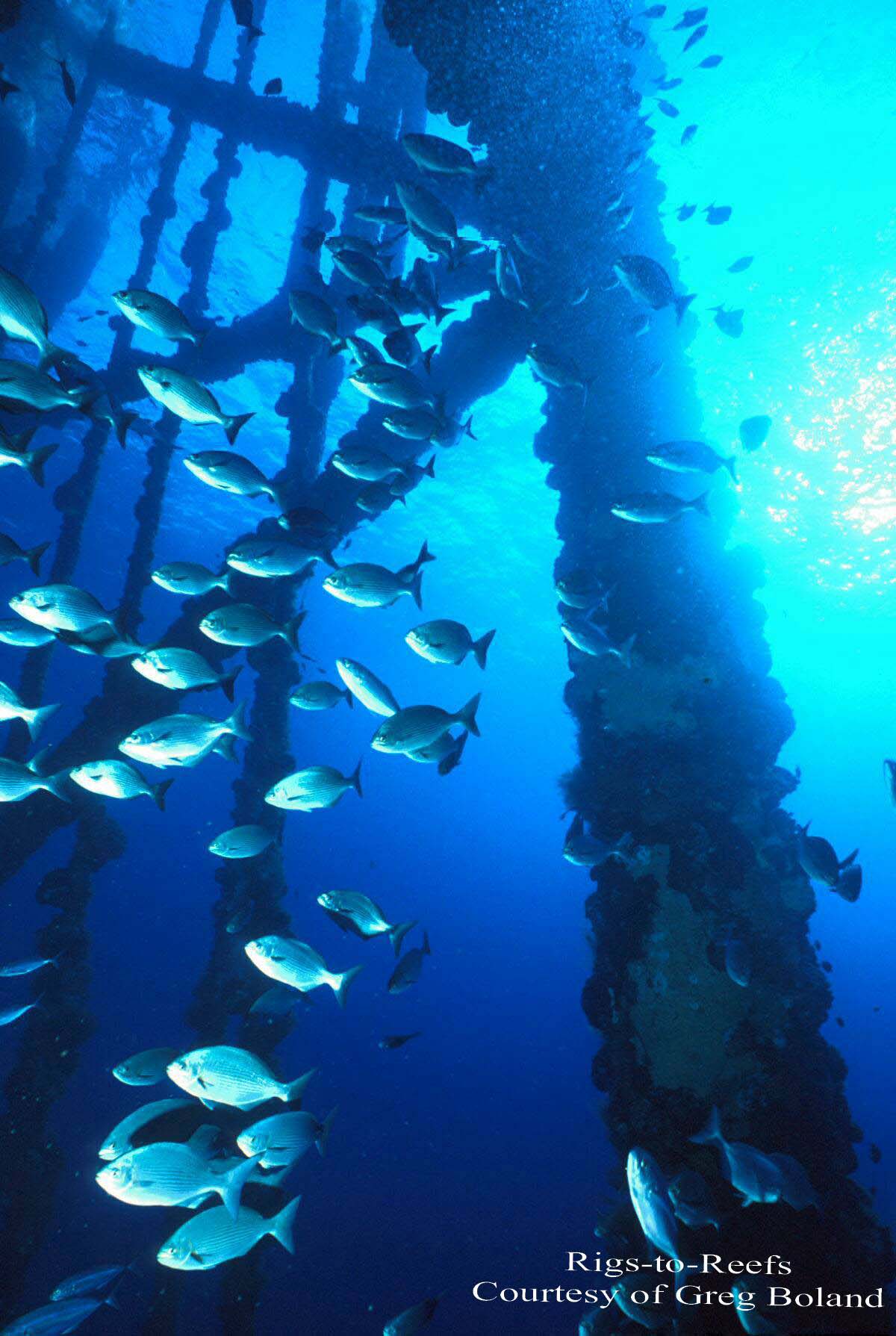
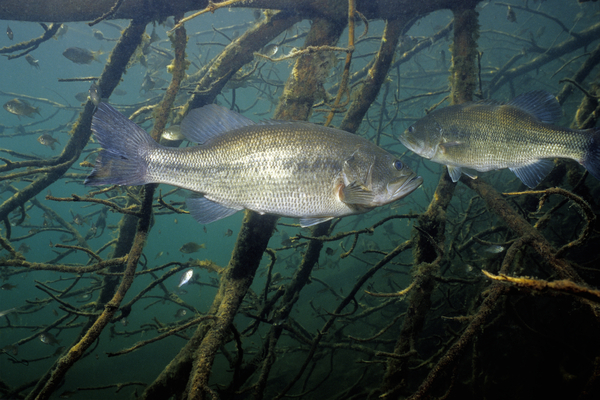
In lakes, reservoirs and water bodies with larger rock, it's almost impossible to control how an object lands once submerged. Stacks of pallets and bundles of trees can simply roll over in a ball and loose much of the potential fish holding cover within, sometimes simply landing on an uneven lake bottom. Although surface area remains, the vertical element has been diminished along with taller fish holding options. Leaning or falling over still adds the important surface area, but measurably decreases the efficiency of it's intended use. When possible, habitat should extend a minimum of two thirds of the depth.
The width of a group of habitat is easily increased by adding more units along the lake floor. The height however, is a far more complicated feat of nature underwater. Natural materials like plants in a lake thrive on one general principle. Roots take hold/anchor and a semi-rigid plant emerges towards the surface, always giving somewhat to the ebb/flow of the water. Standing timber holds root on the lake floor, as the trunk and limbs flex with water movement and soften with age. Wave action and boat traffic can adversely affect the lifespan of standing timber.
We have learned from nature, that a completely rigid member does not fare as well. Artificial habitat not unlike skyscrapers, are best designed to bend and flex with lateral applied forces. If to much force is applied laterally like waves or a hooked fishing line to a rigid structure, it falls over. Being unable to flex with the blow, let alone stand itself back up, the object simply falls over, never to stand vertical again. To achieve sustained vertical height, an object must be allowed to flex and bend with changes around it, while staying firmly planted with down pressure, weight or grip. Integrated buoyancy occurs naturally in plants and wood for some time, helping them to stay standing vertical. Fishiding Reclaimed Artificial Habitat has achieved this artificially in habitat models with Vertical UpRiseTM*.
Vertical UpRise TM*, allows these habitat units to stand vertical on any terrain or slope with the incorporated weighted base and built in vertical lift. In the event a fisherman's line runs through the structure, the base will stay put, allowing the unit to flex and/or lean over before standing back up vertical. This is extremely beneficial when units are deployed landing on large rocks, boulders or steep slopes, they simply can't fall over.
If shallow habitat is allowed to break the water's surface, predator fish are unable to cruise over the tops of the cover to feed on small fry/forage that get to close to the surface for a look. This much overlooked detail can save many forage fish and fry from being eaten to early and to small.
10.Color:
There has been speculation and opinion for years that color matters to fish when it comes to attractors and habitat, many stating dark colored products are preferred by fish. In every body of water, nutrients cling to surfaces creating periphyton/algae. Most waters in the U.S. have high enough nutrient loads to cover habitat in a dark greenish brown fuzz in just days or weeks, completely "hiding" any original color of habitat material. My underwater photographer friend Eric Engbretson, first approached me about this very subject.
Eric assumed the lighter colors may not work as well because he rarely sees fish on submerged birch trees. The assumption has been made before that fish don't want to be a "silhouette" against a light background, especially within a pristine infertile lake with little weed growth. Eric's experience also assumed that in such a pristine environment, little growth would occur on the PVC limbs, thus hiding the color.
What we found is that fish did in fact congregate and utilize both light and darker colored units and a substantial amount of growth and "disguise" did occur. We also observed more growth some years than others, assuming the variation in winter, ice, water temps. that have been all over the board in Illinois, Michigan, Minnesota and Wisconsin lately.
In clean/clear lakes with sand/rock bottom without weeds, the fish will often be lighter in pigmentation/color because of their surroundings. Eric found that the panfish in his lake may actually be using this lighter background to their advantage, with some of the background material color still visible through the growth of periphyton. Shiners and light colored fry also felt at home in the lighter and newer installed cribs.
"When artificial cribs made of PVC pipe first appeared, it was widely believed that they would be less effective because fish would refuse to be silhouetted against a white background. Although I also originally believed this, I've reversed my position. What we've discovered in further studying this is that color doesn't seem to be the significant factor we once thought it was. In fact, there's evidence that suggests that PVC pipe color plays no role in fish preference whatsoever. Instead, the combination of vertical height and complexity determine whether any structure, natural or artificial, will be attractive to fish." (E. Engbretson)
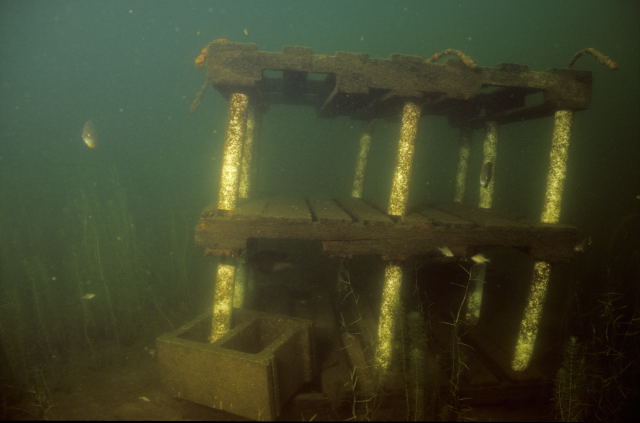
We have to remember what we hope will be able to hide within our artificial habitat. Our goal is to harbor small fish and forage, giving them refuge from predator fish roaming the perimeter. Big fish will find and eat little fish if they are in the lake. Don't worry much about the bigger fish being able to hide well enough to catch a meal, they wouldn't be big without having learned how.
A side benefit we discovered was new weed growth around the artificial habitat, where there had been none before. Fish spending time in an area, fertilizing the lake bottom and growing more real natural habitat, another positive effect of improving fish habitat long term in the same spot.
Until a published paper is available proving data showing a particular color is preferred by any freshwater fish, we will continue to follow what the fish have been showing us underwater. Color appears to be only a concern to the consumer, not the fish and it's definitely not what determines good habitat for them to feel safe. Fish will utilize the best available cover to suit their current needs.
Why are steep rocky points that have a little wood on them and some weeds of maybe a few different varieties, so often a great spot to find fish? It's the variety of shapes, textures and sizes, along with the different temperatures the materials absorb and emit, giving fish true selection of comfortable habitat. Why wouldn't we try to follow this type of variety in artificial products as well, mixing up the shapes, sizes and complexity of units installed?
11.Weight/Anchoring:
Weight under water is a very interesting subject. What an object weighs above water is quite different once submerged. The formula is based on displacement of water weight, in particular. By subtracting the weight of the water displaced from the actual object above water weight, final weight of unit under water is achieved. Now, adding in the variables regarding bottom makeup, slope and currents, it's not as easy as appears to "display" an object in any desired position underwater and make it stay there. If a habitat unit is allowed to move about to much on a rope/cable, it becomes less effective as our testing has shown. Fish seem to expect to find their house where they left it last.
Cement blocks, anchors, rocks and such all require a cable or rope to attach to the habitat. Wood, logs, pallets and brush need a great deal of weight to submerge and also need some type of lashing materials. The biggest and possibly only negative part of this method is snagging fishing lines on the ropes or cables. Not the end of the world, but a bummer when a nice fish wraps you up in that cable or chain. Aside from purchasing and connecting a separate anchor, this method is more difficult to install. Care needs to be taken as weights, ropes and large bundles of habitat flop overboard.
Fishiding artificial fish habitat products have an exclusively patented self contained and weighted base, which not only holds the limbs together and the habitat unit to the bottom, but also keeps the habitat unit standing vertical in the water column. This concept in artificial habitat installation ease, allows user to install without any tools or loose parts. Balance is achieved in each individual model of habitat by size, weight and surface area and how it relates to displacement underwater. Bend and toss.
12.Assembly time/supplies/tools:
Gathering, building and installing artificial habitat can be fairly fast or take quite some time, depending on material selection. Most companies supply all needed parts and instructions, but the consumer may need to purchase anchors. Gathering pipe, spools buckets and fasteners, along with weights/cement to build your own is a good option, but tools needed to complete are common. In trials tests, it took us 5 minutes to unfold and bend a Fishiding 8/0 HighRise habitat unit. (no tools) Just over 15 minutes to assemble the trunk with 12 limbs, including the installing supplied shims and cable for the anchor block we supplied. (tools needed) The molded cone with rigid pipes took over 30 minutes to fit the almost 100 pieces together, all of which floated without considerable added weight which was not included in our box.(tools needed)
Over the years, a number of clients ordering in bulk have asked about helping speed the process of habitat installation. It's work, nothing short, but far less than cutting and bundling brush/wood. The benefit most important, is that the fish now have long term habitat forever. Artificial products are worth the time spent it takes installing, creating cover for countless years and generations of fish and fisherman.
Fishiding also offers numerous models from shallow to deep water that self un-fold straight from the box, to be directly tossed in without any need to shape or bend.
As project size has increased with number of habitat units in the thousands being installed, Fishiding has developed a line of self opening habitat units. Limbs flexible enough to be dropped into the lake right out of the box and come to life underwater. Models from the new ultra fine Cradle to the Fortress and even larger and mysterious Fishadow. If time is an issue, Fishiding has habitat models to fit the needs of you and your fish!
13.Cost of habitat/cost per square foot of surface area/ cost of equipment or additional supplies:
When selecting a type of habitat product for your lake and comparing costs and options, compare both the cost of the model/unit you like but also the cost per square foot of surface area. Square inches or cubic feet are not the same as square feet, measuring inside pipes or tubes is deceiving, as these areas don't get any sun light or any observed use by fish.
Diatom based periphyton needs sunlight to grow, so only the surface pointing upwards getting light, grows fuzz. Round tubes and pipes have surfaces that lack this topside facing surface area to accurately compare algae growth, nor do they cast shade like wide, flat surfaces. Space inside tubes or pipes receive no sunlight and can be to small for fish to utilize, thus not adding any benefit to the fish or the added surface area.
When selecting artificial habitat for your project, take into consideration the installation time involved, start to finish and picking up additional supplies if needed. Preparing and sinking habitat can be as simple as opening a box and dropping it off the pier. In contrast, trips to the store, borrowing a larger boat, getting help, tools, cinder blocks, plastic bases, covers, shims, hammers, drills, mixing concrete?. Putting in a few of anything isn't bad, but consider what it will take to install 50 or more and what your time is worth. We took a long time to degrade the habitat in our waters, expect to spend some time giving back.
Currently, completed retail artificial habitat prices including shipping range from under $.70 cents per square foot, to well over $4.00 per square foot. If the surface area of any given artificial fish habitat model isn't noted, then you should ask and compare.
Fishiding.com currently produces habitat models from $20 up with surface areas ranging from less than 5 sq. ft. to over 200 sq. ft. per unit.
14.Location of installation:
Fish spend the majority of their time within the littoral zone, generally from 15' up to zero. This is where a natural lake would have healthy weeds, dead fall timber, maybe some rock and piers etc. Fry are hatched in the shallowest of cover and transition to mid and deeper depth habitat as summer progresses and they grow larger. This is where we have lost the vast majority of our natural fish habitat throughout our nation.
Installing habitat in only in deeper water will often simply attract passing game fish, but not the warmer water that forage and young of year seek out. These deep habitat spots hold fish late summer through winter as weeds die off, but water that's to deep can at times, be oxygen deprived and unable to support fish in some waters. Turnover and thermocline are keys to depths fish will spend time, but not all waters experience this annual change. Put the cover where the fish want and need to be, not where you think they should hang out.
Shallow water from eight to ten feet and under is most important in most waters. These depths hold a smorgasbord of lifeforms to thrive together in unison. Bugs, insects, periphyton, fry and more, enjoy the shaded and densely populated shallows. This area is the grocery store of the lake, and where more cover equals more fish to feed, breed and need to be part of the balance. The littoral zone ends where the natural cover/plants stop growing. If your goals are to grow more and bigger fish...The littoral zone is where this happens. Fill the shelves and all will eat. Habitat under docks and floating piers are excellent options. These places are already providing fish shade and overhead cover. Add texture, dimension, height and surfaces to create truly fantastic fish habitat.
North ends of lakes generally warm first in the spring and tend to be a preferred area to spawn. These types of areas need dense cover nearby for newly hatched fry to take refuge within, before someone eats them. Best to create lines of habitat from shallow groupings into mid depth areas filled with cover. Protection while traveling out is imperative to increasing young fish survival. Just a few short months more of growing time, will make a meal for another fish instead of a snack. A bass does need to eat 10 pounds of forage fish to gain one pound in body weight. Grow more food in the shallow areas and predators will have plenty to eat to get real big.
Until recently, artificial habitat was generally dropped in somewhat level lake bottoms to avoid tipping over and land in an un-desired position. Now with fishiding's Vertical UpRiseTM*, habitat can be dropped down steep underwater cliffs and slopes, creating cover along the secondary break lines and travel routes, identical to standing timber. The ability to stand vertical and provide cover for predators hunting the shallower cover, allows installation where none could stand before.
15.Versatility of intended use:
Both artificial fish habitat and artificial attractors generally start their intended use by being installed into a lake or pond. These units dropped off boats, generally are never seen again above water. Large piles of timber, brush and the like, certainly are intended to stay put on the lake floor, indefinitely.
While most leading companies selling artificial products have numerous way to sink, float or suspend units, only Fishiding appears to have diversified into other uses and markets. Continuous variety and variation of materials has allowed Fishiding Reclaimed Artificial Habitat products to be used in many different ways. Lakes, ponds, rivers and brackish waters would be the obvious settings. Projects in the U.S. and abroad including: fish hatcheries, aquaculture, garden/koi ponds, aquariums and erosion control, continue to utilize the stable and life-like materials that run throughout the artificial fish habitat line of reclaimed PVC materials.
With over 20 models ranging from eighteen inches to fifteen feet tall, self opening and bend by hand, build your own with loose materials, or toss in lake right out of the box, Fishiding .com is a company truly promoting fish habitat improvement.
Suspending reclaimed pvc units into grow ponds for shrimp, only to be switched out with new fry to consume the periphyton growth formed on the surfaces from their parents. This is a case of massive surface area for nutrients to be cycled naturally back into food, working well in Belize.
Massive clusters of fine, dense and snarled cover to allow shoreline stabilization, fish habitat and keep sediment from entering waterway. Planted in dry riverbed like balled bushes, creating shoreline erosion control while creating fish habitat. Allegany Reservoir/River. Seneca Nation Of Indians.
Weighted habitat units for hatchery fish development, stay in place in grow ponds while helping fish learn to navigate and hunt within habitat before release. Re-usable, safe cover that can be disinfected between different species and batches of fish. Specific habitat models for use in forage grow ponds, increasing yields. Studies have shown that by installing habitat in barren hatchery pond settings reduces fish stress, which in turn grows healthier, smarter, certainly happier and hopefully...... superior surviving, well adapted fish. Initial study data has shown increased size and weight of musky grown in Fishiding habitat vs. control/s. Ongoing pit tracking study in progress to monitor long term survival after release. Increase in bait fish reproduction observed as possible additional benefit within habitat grow ponds. Various sizes and shapes available to accommodate tanks, ponds and raceways can be made for any/all species.
"Planting" habitat in a dry lake bed or Reservoir has become an important tool for fisheries professionals. Like individual bushes and trees, each unit is planted in a shallow hole on the dry bed and filled in around the base. This type of installation allows installers to "landscape" entire area, ensuring swift currents and water fluctuations have no adverse effect, often grabbing additional debris and bolstering effectiveness of units year to year.
16.Fishiding Facts:
When Fishiding.com began producing reclaimed artificial fish habitat products in 2007, little attention had been given to artificial habitat and mainly plastic materials. Dozens of patents are held for fish attracting devices, very few are designed to harbor and produce more fish species.
From the beginning at Fishiding Reclaimed Artificial Fish Habitat, we have been driven to provide true artificial habitat that fish will prosper within and flourish. Reading pages of information from the National fish habitat Action Plan that first year back in 2007, exposed what dire need our Nation's water's are actually in. If you fish, take a look at how many fish have gone extinct in the last 50 years and you'll see why improving lost habitat is so important. We have much to do.
The Fishiding team had a goal that was almost opposite of a fish attractor. Creating true artificial fish habitat for smaller fish to find refuge and making them harder to catch from the big fish. Big fish still come after, little fish right? We aren't looking to attract them, our goal is to have them already live here safely, breeding and growing within the protective space our habitat provides. When the fish have plenty to eat, so do the fisherman that chase them.
Learning much from numerous professionals in the industry about periphyton and the relationship of the surface area and the benefits to the fish, we began to write about it. Long before others understood it's importance, Fishiding had understood the need to maximize the amount of surface area presented in each of their models from the start. Existing attractor companies apparently never thought of protecting the fish as opposed to catching them. Over five years went by before other companies began to use "habitat" in their names and product descriptions instead of attractors. No shrubs, logs, cages or havens back then, simply "secret fishing spots".
"Protection for the little guys" was coined by fishiding back in 2007 with the first website and original Cradle shallow models. The fish needed cover to escape predators from the air and land, as well in the water. Hiding spaces for the fish to grow up is the key in any body of water. It all starts shallow with babies and food, protection and safety.
The term "Fish attractor" has been well known with the intended use being solely to congregate fish to aid fisherman to catch. "Attract them and stack them", "create your secret honeyhole".
Fishiding started out with three original models that still lead in company sales today. The Cradle , The Safehouse and The Keeper cover water depths from 24" deep up to about 10 feet. Originally not perceived by pond managers as very "pretty to the eye", they utilize an abundance of discarded pre and post consumer PVC, in which the designs, textures, flexibility and buoyancy of numerous types of PVC material combine, creating true artificial fish habitat. No two units of any model are exactly the same, with continuous variation in materials and thickness/rigidity. Handmade.
A friendship was born between Underwater fish photographer Eric Engbretson and Fishiding owner, David Ewald over the mutual concern surrounding fishes in general and their respective habitats. Not a fan of fish attractors and the advantage they provide anglers, Engbretson was leery of Ewald's products and intentions. Skeptical at first, now Eric continues to help develop, criticize....... and "open our eyes" to his years of experience with fish underwater and their continuously apparent, underwater preferences. It's about the earth and the fish, not making money.
With a mutual love for all things fishy, it was quickly understood that our work together was for the fish, creating first of it's kind truly artificial fish habitat. Location, vertical height, ease of use and color have all been long lasting discussions, improving models along the way being directed by the fish. When things don't work as well, it's back to the shop for another few attempts and prototypes. Multiple times per year prototypes go into multiple lakes and both teams scuba dive to observe and photograph a multitude of configurations. New designs both from fishiding and of others, get installed side by side and let the fish tell us what they prefer. Individual units and large complex groupings provide data which keeps us forever looking for improvement and even more variety. We feel we have found and achieved a best case scenario for fish.
This is the only way to actually know what fish prefer, try it yourself and see.
Materials from the construction, medical, printing, manufacturing, automotive industries and more, all combine to provide endless possibilities of design and fish friendly spaces with reclaimed PVC destined for landfills. With nothing pre-made, manufactured or subcontracted, the Fishiding team strives to produce the only reclaimed artificial fish habitat for the protection and well being of the fish and the environment, continuing to support all others involved in the same.
See our ten part underwater time lapse, still and video series here.
Photo credits: to Eric Engbretson Underwater Photography and Graham.Buss Photography
